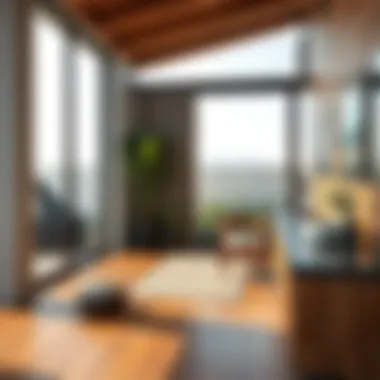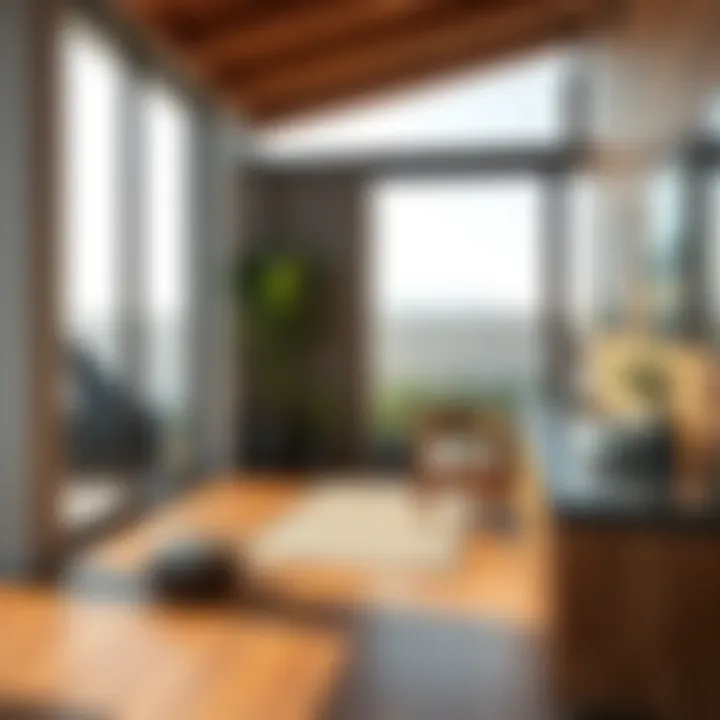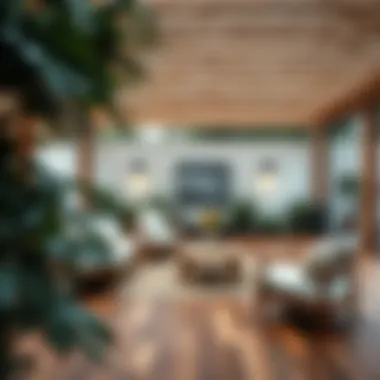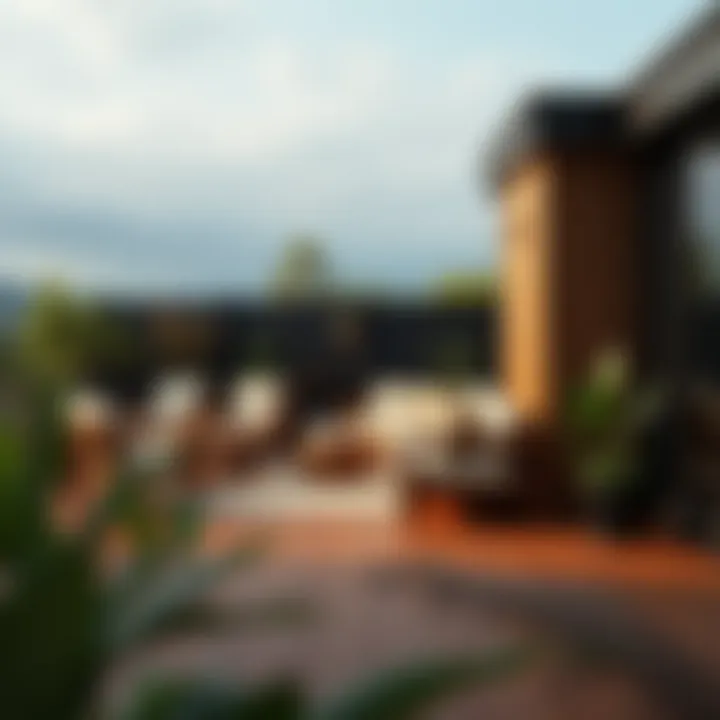A Comprehensive Guide to Outside Wood Tiles


Intro
In the world of outdoor design, the choice of materials can significantly elevate the aesthetic and functional appeal of any space. Outside wood tiles, often overlooked, serve as an exceptional option for homeowners and designers alike. Their charm lies not only in their natural beauty but also in their versatility. Whether used for pathways, patio flooring, or garden borders, these tiles seamlessly blend with various styles, from rustic retreats to modern minimalist settings.
This guide is tailored for those looking to enhance their outdoor spaces, diving into the features, benefits, and practicalities of outside wood tiles. From understanding the diverse materials available to exploring installation processes and maintenance challenges, this resource is structured to provide a comprehensive view for every discerning reader interested in making informed choices.
As we roll up our sleeves and dive into the nitty-gritty, we’ll uncover the latest trends shaping outdoor design, insightful tips for selecting the right materials, and innovative applications that resonate with sustainability and style. Thinl about what an outside area can become; this guide is all about transforming visions into reality, ensuring your outdoor spaces stand the test of time both in form and function.
Prologue to Outside Wood Tiles
As outdoor spaces continually evolve, the importance of choosing the right materials for those areas cannot be overstated. Outside wood tiles have rapidly gained traction among homeowners, designers, and decorators alike. They serve as a versatile flooring option that enhances the aesthetic appeal and functionality of outdoor areas. By integrating these tiles, one can transform ordinary patios, decks, and gardens into inviting sanctuaries.
Defining Outside Wood Tiles
Outside wood tiles are specially designed tiles intended for exterior surfaces, crafted primarily from either natural wood or innovative composite materials. Unlike indoor wooden flooring, these tiles endure the rigors of outdoor elements, displaying impressive resilience against UV rays, moisture, and temperature fluctuations.
Often available in various sizes, finishes, and colors, they cater to a range of stylistic preferences and architectural designs. Whether it’s a rustic cabin look or a modern sleek finish, there's likely an option to suit.
Composition: Traditional wood tiles typically consist of hardwood species such as teak, cedar, or redwood, celebrated for their natural oils that provide some level of protection against weathering. On the other hand, composite wood tiles are engineered from a mix of wood fiber and plastic, emphasizing durability while retaining a wood-like appearance. The main goal here is to strike a balance between look and longevity, allowing aesthetics to merge seamlessly with practicality.
To sum up, understanding what outside wood tiles are and their underlying traits is essential for anyone looking to make substantive improvements to outdoor spaces. This selection not only adds value to the property but also elevates the comfort and enjoyment of the space. It’s not just about flooring; it’s about creating an experience.
Benefits of Outside Wood Tiles
Outside wood tiles offer a range of advantages that make them an excellent choice for enhancing outdoor spaces. Understanding these benefits is essential for homeowners, designers, and decorators looking to create inviting and durable environments. Here we outline three critical advantages: durability and weather resistance, aesthetic versatility, and environmental sustainability.
Durability and Weather Resistance
One of the standout features of outside wood tiles is their remarkable durability. Unlike standard wood, which may suffer from the elements, outside wood tiles are engineered to withstand harsh weather conditions. Think of how rain, snow, and sun can take their toll on outdoor surfaces. With quality outdoor wood tiles, you can lean back and not worry as much.
These tiles are typically treated with preservatives, offering a safeguard against moisture, mold, and oxidation. This means less maintenance and longer-lasting enjoyment. For instance, teak and cedar are common wood types utilized in these tiles due to their natural oils that repel water and resist decay. Furthermore, many manufacturers now offer tiles with added UV protection, ensuring that the colors and finishes remain vibrant over time.
“Investing in durable tiles is like putting money in the bank for your outdoor space.”
Aesthetic Versatility
Another compelling reason to consider outside wood tiles is their aesthetic versatility. These tiles come in various sizes, colors, and textures, accommodating just about any design vision. You can create a seamless look that flows from an indoor space to your garden or patio, enhancing the overall ambiance. There’s a charm that only wood can bring, with its warm tones and natural grain.
Homeowners often find it easy to play around with patterns and arrangements. For example, laying tiles in a herringbone pattern can elevate the look significantly as opposed to traditional grid arrangements. The ability to mix and match tiles means individual preferences can truly shine, giving spaces a personal touch that resonates.
Here are a few popular design approaches:
- Mixing finishes: Combine matte and glossy tiles to create depth.
- Color palettes: Choose shades that reflect the surroundings, making nature feel integral to your design.
Environmental Sustainability
As awareness around environmental concerns rises, the sustainability of outdoor materials has become paramount. Many outside wood tiles are sourced from responsibly managed forests, making them a suitable option for eco-conscious consumers. By opting for these tiles, homeowners reduce their carbon footprint while beautifying their spaces. This is particularly true for bamboo tiles, which have gained popularity due to their rapid regrowth and renewal properties.
Additionally, composite wood alternatives incorporate recycled materials, providing an eco-friendly choice without sacrificing aesthetics or performance. Keeping an eye on certifications like FSC (Forest Stewardship Council) is essential when selecting tiles to ensure sourcing is sustainable.
In short, choosing outside wood tiles not only elevates outdoor aesthetics but also supports a healthier planet, proving that style and sustainability can indeed go hand in hand.
Material Options for Outside Wood Tiles
Choosing the right materials for outside wood tiles is crucial. The options available not only dictate the style and function but also influence longevity and environmental impact. Homeowners, designers, and decorators should consider these elements to ensure that their choices align with personal preferences and practical needs.
Types of Wood Used


When it comes to wood, several species are ideal for outdoor use. Among the most popular are:
- Teak: Known for its natural oils, teak resists moisture, making it an exceptional choice for outdoor areas. Its aesthetic appeal, thanks to rich, warm tones, gives a sophisticated feel.
- Ipe: This type of wood is often referred to as Brazilian walnut and is incredibly dense and hard. Ipe boasts superior resistance to decay and insects, ensuring it stands the test of time. It's a bit pricier but worth every penny for those who prioritize durability.
- Cedar: Naturally rot-resistant, cedar provides a lovely aroma and a warm color palette. It's a favorite among those looking for a balance between cost and longevity.
- Redwood: Like cedar, redwood has natural resistance but adds a beautiful reddish hue to outdoor spaces. It's lightweight yet strong, making it easy to work with.
Using wood species like these also supports local lumberyards and sustainably managed forests, fostering ecological responsibility.
Composite Wood Alternatives
Composite wood tiles are rapidly gaining traction. These products blend various materials, usually a mix of recycled wood fibers and plastic. The benefits of using composite wood often include:
- Low Maintenance: Unlike traditional wood that may require regular staining or sealing, composite options typically need only occasional cleaning, saving time and effort.
- Variety of Styles: Composite tiles provide versatility in appearance, mimicking the natural wood look while offering a wider selection of colors and textures.
- Sustainability: Many composites use recycled materials, reducing waste and environmental impact. This attribute resonates well with a more eco-conscious audience.
- Cost-Effective: Although the initial price can be on par with high-quality hardwoods, the long-term savings from maintenance and repairs often make composites a more economical choice.
Tip: When deciding between wood and composite, consider climate factors in your area. Some materials may perform better than others depending on exposure to water, sunlight, and temperature variations.
For further detailed information about the characteristics of different types of wood, you can check out resources on Wikipedia or Britannica.
Installation Process
The process of installing outside wood tiles is an indispensable component of any successful outdoor transformation. It encompasses various essential steps that impact not just aesthetics but also longevity and functionality. For homeowners and designers alike, understanding this process is crucial to achieving a durable and visually appealing surface that withstands the elements. Inadequate installation can lead to a range of issues, including warping, water damage, and reduced life span of the wood tiles. Thus, getting the installation right is vital to the success of your outdoor project.
Preparation Steps
Before diving into the hands-on aspect of installation, preparation is key. This phase sets the stage and ensures the tiles adhere properly, avoiding future headaches. Here’s a breakdown of the important preparation tasks:
- Assessing the Area: Begin by examining the space where the tiles will be installed. Look for any uneven ground or drainage issues that might necessitate addressing. It’s crucial to have a solid foundation, as this will form the basis for a level and stable installation.
- Clean the Surface: Clear the area of all debris, soil, and vegetation. A clean slate helps with the adhesion of tiles, preventing moisture from becoming trapped underneath.
- Gather Tools and Materials: Ensure you have all your tools ready. Typical tools include a mallet, level, measuring tape, and tile spacers. Having everything at hand before starting can save a lot of time.
- Plan the Layout: Determine how you want to lay out your tiles. It might help to create a small sketch or use a chalk line to visualize placement. This planning can prevent the trial-and-error approach once installation begins, resulting in a cleaner look.
By covering these steps, you prepare the site effectively and set the stage for smooth installation.
Laying the Tiles
The actual laying of the tiles is where the excitement begins. This stage should be approached with care to ensure an even and consistent result. Here’s how it generally unfolds:
- Starting Point: Many installers begin at a straight edge, such as a wall or patio border. This ensures that the first few tiles are aligned perfectly.
- Tile Placement: As you lay each tile, use spacers to maintain consistent gaps. This is particularly important for expansion joints, especially for wood products. Adjust your positioning frequently with a level to avoid any unevenness.
- Cutting Tiles as Needed: Do not be surprised if some tiles need cutting to fit in tight corners or alongside edges. Using a tile saw or jigsaw for adjustments will make your layout more precise.
This is a meticulous process, but taking the time ensures that the patio or pathway will look great for years to come.
Sealing and Finishing
Once the tiles are laid and any excess materials cleaned up, it's time to focus on sealing and finishing to protect your work. This stage is often overlooked, but it plays a significant role in the durability and tenacity of the tiles:
- Selecting Sealant: Depending on the wood type used, choose an appropriate sealant. The choices range from oil-based finishes to water-resistant products. Check the manufacturer's recommendations to match the product with the tile material.
- Applying the Sealant: Follow the instructions carefully when applying the sealant. Using a brush or sprayer can help in achieving an even coat. Be sure to cover all edges and crevices.
- Allow to Cure: Sealing isn't a rush job. Allow the product ample time to cure based on the instructions. Rushing this step could diminish the protective qualities of the sealant.
- Regular Maintenance: Finally, develop a routine of maintenance after sealing to ensure the longevity of your tiles. Regular checks and reapplication of the sealant as needed can go a long way in preserving their beauty.
Investing time and effort into these installation processes is ultimately a decision that will pay dividends in the appearance and resilience of your outdoor wood tiles.
Maintenance of Outside Wood Tiles
Proper maintenance of outside wood tiles is essential for preserving their beauty and longevity. Without it, those appealing tiles can easily succumb to the harsh realities of the outdoors, significantly diminishing their lifespan and aesthetic appeal. By addressing maintenance, homeowners can ensure their outdoor spaces remain inviting and functional.
Regular Cleaning Practices
Keeping outside wood tiles clean is a straightforward yet vital element of maintenance. Regular sweeping or brushing to clear away dirt, leaves, and debris helps to prevent the accumulation of grime that can lead to decay. For a deeper clean, a gentle scrub using a mixture of soap and water can work wonders. Here’s a simple routine you can adopt:
- Sweep or brush the tiles weekly to remove surface dirt.
- Mix warm water with a mild detergent.
- Use a soft-bristled broom or cloth to scrub the tiles gently.
- Rinse with clean water and let them dry naturally.
It's important not to use harsh chemicals or pressure washers, as they can damage the natural wood fibers and finish. Regular cleaning not only enhances the appearance but also wards off potential issues like mold or mildew, which thrive in damp conditions.
Addressing Wear and Tear


Despite being robust, outside wood tiles can experience wear and tear over time due to weather exposure, foot traffic, and even pets. Keeping an eye on any signs of damage is crucial. Common issues include:
- Fading of color due to sun exposure.
- Splitting or cracking from moisture absorption.
- Warping caused by extreme fluctuations in temperature.
When these problems arise, it’s best to address them promptly. Here are some effective strategies for managing wear:
- Fading: Periodic resealing can help maintain color and protect the wood.
- Splitting: Small splits can often be filled with a wood filler designed for outdoor use.
- Warping: If tiles warp, consider replacing individual pieces rather than the entire surface to save resources and time.
Being proactive in addressing wear can extend the life of your wood tiles significantly.
When to Refinish
Refinishing is another crucial aspect of wood tile maintenance. Signs that it might be time to refinish include a dull appearance, noticeable scratches, or a rough texture underfoot. Generally, tiles may need refinishing every 1 to 3 years, depending on factors such as:
- Climate: Humid climates may require more frequent attention.
- Usage: High-traffic areas will wear down finishes faster.
- Material Quality: Higher-quality woods usually withstand the elements better and may require less frequent refinishing.
A typical refinishing job involves:
- Sanding the surface to remove the old finish.
- Cleaning thoroughly to eliminate dust and debris.
- Applying a suitable outdoor sealant or stain to enhance protection.
By understanding when to refinish and how to do it properly, homeowners can maintain the wood's resilience and beauty, ensuring their outdoor areas remain pleasant and valuable.
"Regular upkeep of outside wood tiles not only preserves their beauty but also enhances the overall quality of your outdoor space."
Design Considerations
When embarking on a journey to elevate your outdoor space with wood tiles, design considerations play a critical role. Not only do these decisions dictate the aesthetic appeal of your environment, but they also affect how the space functions. Homeowners and designers alike must consider various elements such as color schemes, patterns, and how the tiles work with existing architecture and landscaping.
From choosing the right hue to ensuring the layout complements the outdoor setting, thoughtful decisions enhance both beauty and practicality. A well-planned design can turn an ordinary patio into a delightful escape, creating a seamless transition between indoor comfort and outdoor activity.
Key elements to explore include the following:
- Color Psychology: Colors can evoke emotions and influence spatial perception, making it essential to select shades that align with your desired atmosphere.
- Pattern Harmony: The patterns formed by the tile layout can either enhance or disrupt visual flow. Considering how patterns coordinate with furnishings and flora is crucial.
- Functional Zones: Creating specific areas for dining, lounging, or gardening ensures your outdoor space is adaptable and inviting.
"Effective design marries aesthetics with functionality; finding this balance is key for any successful outdoor space."
Color and Pattern Coordination
Selecting the right colors and patterns for outdoor wood tiles is more than just a matter of taste. It involves understanding how these choices influence the overall ambiance of the space. For instance, lighter shades can make a small area feel expansive and airy, while rich, darker tones can create a sense of coziness. The interplay of colors with the surrounding elements—like greenery or stone pathways—can greatly enhance visual appeal.
Patterns, whether horizontal, herringbone, or checkerboard, offer unique storytelling through tile placement. Mixing and matching should be approached with caution; a busy design can overwhelm the senses and make the area seem cluttered. Here are some guidelines to consider:
- Complement Existing Features: Look at the colors and materials in place. If the home features rustic stonework, earthier tiles can unify the look.
- Emphasize Focal Points: Choose contrasting patterns or colors to highlight specific areas, such as a seating area or fire pit.
- Seek Harmony: Stick to a palette that resonates through the entire space, ensuring all aspects feel cohesive rather than haphazard.
Creating a Cohesive Outdoor Space
A key goal in designing outdoor areas with wood tiles is to create a seamless, cohesive environment that feels intentional. The variety of textures, colors, and layouts must unite to tell a story. It goes beyond the tiles themselves; furniture, lighting, and plant life all play a vital role in this narrative.
For instance, if your wood tiles are a warm cedar, pairing them with complementary furniture in soft beige or leafy greens will help draw the eye. Another consideration is the balance between hard and soft surfaces; the wood should work well with other materials like stone or metal without clashing.
To achieve a cohesive space, consider these strategies:
- Define Areas Clearly: Use tiles to delineate different functional spaces. A transition from tile to grass can signify a shift from dining to lounging.
- Incorporate Natural Elements: Select plants that echo the colors of your tiles for a unified look; let nature fill gaps and provide softness to hard surfaces.
- Layering Textures: Balancing the smoothness of the wood with the roughness of stones or soft fabrics in cushions can add depth to your surroundings.
A well-thought-out design relies not just on the visual but also on the sensory experience, ensuring that all elements work together to create an inviting and easily navigable outdoor retreat.
Innovative Applications


Innovative applications of outside wood tiles extend beyond the traditional use of flooring. These tiles not only provide aesthetic value but are also practical in various outdoor settings. The trend towards using sustainable materials in outdoor spaces highlights the necessity of understanding how these tiles can be implemented creatively and functionally. Elements like slip-resistance, durability, and weather resilience become crucial in places where the tiles will face challenging conditions. Homeowners and designers alike are looking to push the envelope with their outdoor designs, transforming common areas into unique experiential spaces.
Patios and Decks
Patios and decks are where outside wood tiles truly shine, combining beauty and functionality. They serve as an extension of your indoor living spaces, creating areas for relaxation and entertainment. When choosing tiles for these locations, consider the foot traffic and weather exposure they will endure.
- Slip Resistance: Tiles with textured surfaces can help prevent slips, especially in rainy conditions. This is a vital consideration for families with children or older adults.
- Color and Finish: Opting for warm tones can enhance the feeling of coziness, while cool tones might provide a more modern vibe. Additionally, finishing the tiles can help to protect them from wear and tear, ensuring they maintain their luster over time.
- Integration: Pair tiles with outdoor furniture and lighting to create a cohesive look. A well-designed patio can transform into a go-to area for summer gatherings, showcasing the seamless blend of style and practicality.
Garden Walkways
Garden walkways crafted from outside wood tiles can transform a mundane path into a beautiful journey through nature. They guide visitors through your garden while adding a touch of elegance. Here are a few key thoughts to consider:
- Natural Aesthetic: Using wood tiles coordinated with the flora enhances the natural beauty of the garden. Varied colors and patterns can mimic the look of natural stone while being much easier to maintain.
- Drainage and Maintenance: Some tiles offer built-in drainage solutions, allowing rainwater to flow freely without pooling. This helps in preserving the garden’s health while ensuring safety for those walking through.
- Versatile Designs: Beyond basic squares, tiles can be arranged in various patterns or layouts, such as herringbone or chevron, adding an interesting visual element to your garden without overwhelming the landscape.
Poolside Areas
When it comes to poolside areas, outside wood tiles present both a classy and functional solution. With heavy foot traffic and constant exposure to water, the right tiles can elevate this space immensely.
- Water Resistance: Look for tiles specifically designed to withstand poolside conditions. They should offer excellent grip and be resistant to moisture, preventing mold and mildew.
- Temperature Control: Some tiles stay cooler underfoot, making them pleasant to walk on during hot summer days. This is essential for comfort, especially when moving from the water onto dry land.
- Decorative Edge: Adding unique color schemes or textures can set the tone for your entire outdoor space. From natural wood finishes to bold, bright tiles—these choices can create a fun, inviting atmosphere.
"Investing in quality outside wood tiles not only enhances the visual appeal of your property but contributes to the longevity of functional outdoor spaces."
By exploring these innovative applications of outside wood tiles, homeowners and designers can create outdoor environments that are both attractive and practical, pushing the boundaries of traditional landscaping etiquette.
Market Trends and Industry Insights
Staying abreast of market trends and industry insights in the realm of outside wood tiles is crucial for homeowners, designers, and decorators alike. As outdoor aesthetics shift and evolve, understanding these trends can help make informed choices that align with contemporary styles and preferences. In addition, recognizing the direction the market is headed allows consumers to anticipate future needs, ensuring their outdoor spaces remain both stylish and functional.
Current Trends in Outdoor Flooring
The landscape of outdoor flooring is undergoing a dynamic transformation. Increased demand for sustainable materials is at the forefront, with many consumers gravitating towards eco-friendly wood options or high-quality composite alternatives. Numerous factors are influencing these trends, including:
- Aesthetic Appeal: Homeowners seek materials that not only look good but are also resilient against weather and wear. Varieties of hardwood, such as teak or mahogany, come in visually striking finishes that catch the eye.
- Technological Innovations: Advances in production technology have led to the creation of more durable and weather-resistant products. Manufacturers are implementing enhanced finishes that promise to extend the life of the tiles, setting a new standard in quality.
- Affordability Without Compromise: With increased competition among brands, prices are becoming more accessible. This shift encourages consumers to explore premium options that were once pricier, allowing homeowners to elevate their outdoor spaces without breaking the bank.
This evolving narrative highlights the importance of design choices that are informed by emerging trends. As homeowners look to create inviting outdoor environments, the choice of flooring material plays a pivotal role in achieving that goal.
Consumer Preferences and Choices
The choices homeowners make regarding outdoor spaces often reflect broader societal preferences. Lately, there has been a noticeable pivot towards multi-functionality and simplicity. As people seek to maximize their outdoor areas, wood tiles that offer both beauty and practicality are gaining traction. Key considerations include:
- Style Cohesiveness: More consumers desire continuity between interior and exterior designs. Across the board, buyers are favoring tiles that offer warm, natural hues to create a seamless transition from their indoor living areas to outdoor environments.
- Personalization: There's a rise in demand for customizable options that let consumers tailor their outdoor aesthetics to fit personal tastes. Many companies now offer various sizes, colors, and finishes, allowing homeowners to take full creative control.
- Sustainability and Health: Homeowners increasingly want to know about the origin and environmental impact of their purchase. Tiles made from reclaimed wood or sustainably sourced materials are particularly appealing, as they align with eco-conscious practices.
The choice of outdoor flooring is no longer just a matter of taste; it signifies larger commitments to sustainability and personal well-being.
Understanding these preferences is essential for guiding purchases and planning. Homeowners and industry professionals alike can harness this knowledge to make choices that resonate not only personally but also with wider environmental and social ideals.
For more details on market trends, refer to Wikipedia's article on sustainable materials or check out insights on consumer preferences on Reddit.
Epilogue
Considering the significance of outside wood tiles, one must note their evolving role in outdoor design. This article emphasizes several critical elements that help shape the future of these architectural components.
First and foremost, the sustainability aspect cannot be overlooked. With more homeowners leaning towards eco-friendly practices, selecting outside wood tiles made from responsibly sourced materials is making waves in landscaping and patio design. This commitment to the environment is not just a trend, but rather a transformative journey that enhances the overall aesthetic while reducing carbon footprints.
Future of Outside Wood Tiles in Design
Looking ahead, it's evident that the future of outside wood tiles is ripe with potential. The landscape is shifting towards innovative design ideas that focus more on marrying functionality with style. Some key trends that are becoming evident include:
- Smart Technology Integration: Imagine wood tiles that can be heated or even self-cleaning, a concept that's not too far down the line. The incorporation of sensors and technology can elevate the functionality of outdoor spaces like never before.
- Customization: As more homeowners want unique expressions of their personal style, manufacturers are responding by offering a wider array of colors, textures, and patterns. This means the traditional aesthetic of wood can now be blended with modern twists, leading to breathtaking outdoor designs.
- Durable Innovations: Manufacturers are exploring enhancements to the durability of outside wood tiles. Upgrading to advanced coatings can protect against moisture and pests while retaining the natural beauty of the wood.
"Sustainability and design are hand in hand, crafting a future where beauty does not compromise our planet's health."
With these shifts, it’s clear how outside wood tiles are not merely floor coverings but integral parts of modern outdoor living solutions. Homeowners and designers alike must stay abreast of these trends, as they hold the keys to elegant outdoor creations that honor both beauty and sustainability. As the use of outside wood tiles continues to expand, understanding their capabilities and future possibilities will undoubtedly enrich the experience of outdoor design.



